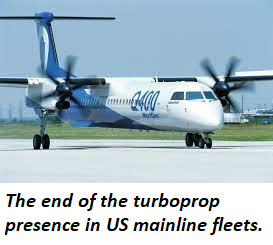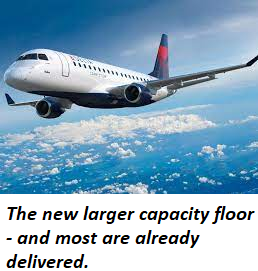The New Unseen Shortage – Airliners
Can’t have air service without airplanes. Airplanes that can make money with current and expected market factors.
Let’s start with this. Time to get real. The evolution in the cost of airline operations is geographically consolidating air service access, and it’s a process that is accelerating. It’s a process that is being driven by complete shifts in airline fleet economics.
Stop The Snake Oil & Look For Economic Airport Alternatives. Air access planning cannot escape this. Another market study, or task force, or leakage analysis, or capture area review, or peer airport chart won’t do diddly when there aren’t airlines interested due to the evolving economics of operations and increasingly limited fleets of smaller airliners.
Airline Fleets Are Not Growing. Quite The Opposite. Here’s a starting point. Small jets – a.k.a. 50-seaters are being retired. Turboprops will disappear by the end of the year in US mainline fleets. Replacement jets are basically E175s, and that order pipeline is almost over. The CRJ line is out of production.
For small and mid-size communities, air service access planning must evolve to accommodate these shifts. The fact is that there is a continuing disappearance of entire fleets of small airliners, and the proper planning is to address the fallout, craft regional approaches, and plan economic airport development – instead of more pied-piper studies that are nothing more than expensive later day cargo cult programs. (Google it, if you must.)
Again, the emerging fact is that we now have an increasing and accelerating shortage of airliners.
Specifically, airliners that have the economics to make money based on available revenue and operating costs – within the strategies of the airline operator. The reality is that these airliners are disappearing – simply because they don’t meet that financial hurdle anymore.
A couple of factoids regarding the next 12 months:
End of Turboprop Airliners. By the end of 2022, the turboprop era in the mainline USA air system will be over. Gone. No more. Alaska  is pulling its final Q400s out of service. This is a process that’s been experienced most lately across the Northwest, where airports have seen reductions in frequency as these machines were retired.
is pulling its final Q400s out of service. This is a process that’s been experienced most lately across the Northwest, where airports have seen reductions in frequency as these machines were retired.
In the case of Alaska Airlines, the next airliner up the line is the E175 – which has completely different and much higher revenue hurdles. That means less frequency – sometimes just one a day – at a number of airports which don’t have the demand horsepower to support more capacity. That doesn’t bode well for natural expectations of “luring” more connective air service.
There are no viable turboprop replacements for the USA market. There’s still ATR-72s in production. There’s the follow-on to Dornier planning an upgraded set of 328 variants. Embraer is looking at a new turboprop platform, too. And these airliners have great potential. But not in the US airline market.
BGI has accomplished a number of global feasibility reviews of new-generation turboprop platforms. The market is restricted because the two biggest airliner markets – US and China – are not in the play. In the USA, the airline system is no longer economically geared to chasing small markets – the return v the cost isn’t there.
China has a real opportunity, but the criminal thugs in Beijing are wedded to a laughable program called the Modern Ark – a blatant copy of the ATR that’s been under gestation long enough to produce a couple herds of elephants, and like most of the CCP government airliner programs is a national embarrassment. They aren’t going to look at foreign platforms.
Larger Airliners – It’s Been In Process For Decades. This airline fleet evolution is really just more of the three decades of air service shifts in the USA, with airliner size within major airline brands going up from what were 19 seaters in the late 1980s to 65-76 seat jets in 2022 being the new capacity floor.
 The 76-Seat Pipeline Is Closing. Another point missed is that the demand for E175s has pretty much tapered off. There are only a few left on order. That means for small and midsize airports looking to recruit service, the competition for airliners will get much tighter.
The 76-Seat Pipeline Is Closing. Another point missed is that the demand for E175s has pretty much tapered off. There are only a few left on order. That means for small and midsize airports looking to recruit service, the competition for airliners will get much tighter.
The 50-Seat “Regional Jet” – Going Fast. This is another factor that most air service planning blindly assumes won’t change. At small lift lessors – still mis-labeled as “regional airlines” – there is a strategic crisis in progress.
There is now a shortage of pilots. Worse, it’s not just pilots, but a shortage of pilots at below market rates as operators are jacking up compensation to keep and attract people in cockpits. That means these human resources need to be used where they can generate more revenues, and that means flying larger airliners. So, the expectations of just having more pilots will bring back small community air service are nonsense.
No More Cheap Go Juice. Then, there’s the fuel shortage we’ve pointed out in the past.
Specifically, a shortage of $1.50 per gallon jet-A. At $3.50 and up it combines with higher pilot costs and increasing maintenance costs to make more and more hub-feed and capacity-addition missions financially impossible where once a 50-seater could make money.
The recent deletions by Delta of markets like CID-DTW, FWA-DTW and MLI-MSP weren’t due to lack of consumer demand. They were due to the raw fact that the costs exceeded the hurdle Delta needed to make a sufficient return.
All Dressed Up With Nowhere To Go – Over 210 CRJ & ERJ Airliners. These economic realities are also a very real issue for the companies operating 50-seat jets. Today, there are still @255 CRJ200s and E145 variants still operating in US mainline fleets.
But there are also over 210 more of these aircraft now parked and dormant. Not retired yet, but sitting unused. As the cost dynamics represented by 50-seat pull-downs at American, United and Delta continue, there will be more of these machines all dressed up with nowhere to go.
The Future: Optimizing Economic Realities. The truth is that the hurdle for connective air service is going up. The fleets available are not growing. More market studies won’t get American or United or Delta to rush down to Brazil and order more E175s.
Instead, communities need to take a more aggressive stance in building their airports as job-generators. All communities, but particularly small communities.
As we’ve pointed out in our Boyd-Swelbar Unvarnished videos and in our Aviation Unscripted videos, small community airports can be huge potential economic generators, with visionary planning.
This does not mean completely giving up on exploring air access. But it does mean that it’s time to realize that the 1980s are over, and the future role of small airports goes way beyond having placebo Cessna Caravan flights. It means having two local flights a day with a 20 minute local drive won’t compete with 80 or more flights 45-60 minutes away, which is a common situation in many areas.
Exploring & Accepting Hard Facts Leads To Results. If you’re looking for true futurist aviation planning, give us a call. We’d love to explore the new future with you.
_________________